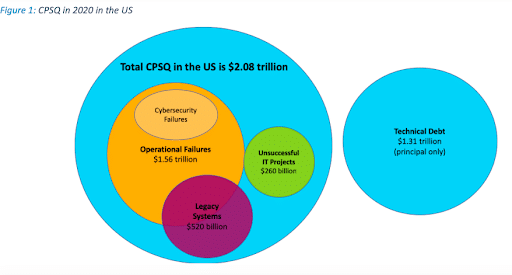If you’re in the software industry, you should know that 70% of tech startups close shop around 20 months after their first capital raise.
And it’s not just companies that crash, either. In the U.S., software development projects saw a consistent 19% failure rate over the last decade, and the cost of unsuccessful projects in 2020 alone totaled $260 billion.

It’s not all doom and gloom, though. The good news is that we know what factors lead to software project failure (most of the time, at least).
3 Common Reasons Software Development Projects Fail
Here are three major causes of software project failures — and how to avoid them:
1. Failing to Create a Technology Roadmap
A technology or IT roadmap is a must, especially if you’re managing large software projects. Roadmaps help improve long-term strategic planning by spelling out the vital steps and elements of the development or implementation process, including:
- Short- and long-term goals
- Priorities, action steps, and milestones
- Time frames and deadlines
- Resources allocation
- Potential risk factors
A good technology roadmap should also address the tech stack, the application and infrastructure architecture, and key CI/CD processes.
That said, roadmaps must not be set in stone. While they can provide a helpful blueprint, you should always aim for an agile and iterative approach to software development that’s based on trial and error and allows you to shift gears as needed and in real time.
Do you want more tips and tricks on how to create a technology roadmap? We wrote an entire post on the subject, so find out how you can create a successful technology roadmap.
2. Skill Gaps or Small Talent Pools
There may be any number of technical factors that explain the somewhat disheartening software project failure statistics we briefly mentioned at the beginning of this article. At the end of the day, however, technology is created by people. More often than not, what makes or breaks a project is the team behind it.
Unfortunately, not all employers have access to large enough talent pools in their areas (or they do but can’t afford to hire local software developers).
If you’re struggling to find people with the right skills for your project, you may want to expand your search beyond the confines of your city or country. By going remote, you can attract incredibly talented — and affordable — software engineers from all corners of the world.
How a Dedicated Development Team Can Help
But what if you need additional human resources but don’t want to go through the pains of recruitment yourself? In that case, consider partnering with an outsourcing vendor and switching to the dedicated development team model (also known as staff augmentation in the U.S.).
Dedicated or extended software development teams are remote engineers who work in close cooperation with your core staff.
This is a collaborative approach, which means that the development process is not fully outsourced. Instead, the two teams work together on the same projects and have common tasks and goals, with the remote developers serving as a seamless addition to your in-house workforce.
Want to set up your very own remote team? It’s easier than you think! To start, click here to learn more about our team augmentation services.
3. Unclear Project Requirements
Our clients often ask us how to manage software development projects more effectively. One of our best tried-and-tested tips is to define requirements as clearly as possible, whether you’re working with your own clients or an outsourcing partner.
This doesn’t mean you need to know everything from the start or that requirements cannot change down the line. Quite the opposite – the success of every project in the fast-paced modern day world depends on adopting a flexible and agile approach of quick iteration and making changes where needed.
What it means is – where the goals and requirements are clear and set – define and communicate them to all relevant stakeholders. Overcommunication is better than undercommunication. Make sure to check, on an ongoing basis, that everyone is on the same page and has the same understanding of the tasks at hand.
When requirements are not clearly defined – explain why and give as much context as possible in order for engineers to understand how to approach the ambiguity.
In both cases – keep the lines of communication and feedback open.
For more in-depth guidance on improving your approach to software project management, explore our software consulting services.
How to Prevent Software Project Failure
Here are three more ways to ensure the success of your software engineering projects:
1. Be Realistic When Talking to New Clients
We get that you may be tempted to close potential deals on the spot. However, that’s not a great long-term strategy.
Instead, do this:
- Don’t oversell and don’t over-promise
- Do your due diligence and ask a lot of questions
- Make sure you understand the client’s requirements before making any commitments
- Always check in with your software development teams to see if the client’s demands are realistic
- Run the proposed project management timeline by your software developers for input
- Leave room for changes in the plan and let the client know
2. Have Proper Documentation
The importance of having a paper trail can’t be overstated. You should document all your business processes, including:
- Your and your client’s requirements
- Any changes to the roadmap
- All strategy and technical decisions
- Deadlines and milestones
- All software project management tasks
Putting everything in writing enables effective communication, prevents misunderstandings, and helps ensure customer satisfaction in the long term.
3. Collaborate Closely with Your Outsourcing Vendor
Working closely with your outsourcing partners is essential if you want your project to be a success. This includes:
- Agile product development approach
- Short development cycles
- Fast feedback loops
- Constant communication — ideally, in real time
That’s precisely how we approach software consulting here at Zartis. Our clients and our consultants work on the development plan together. This allows us to design systems that can not only handle but also actively anticipate change and make room for innovation and continuous improvement.
Don’t Leave Your Software Development Projects to Chance
The software industry is highly competitive, but with an experienced partner like Zartis by your side, it’s easy to get ahead. Together, we can ensure that your next software product will be a success.


